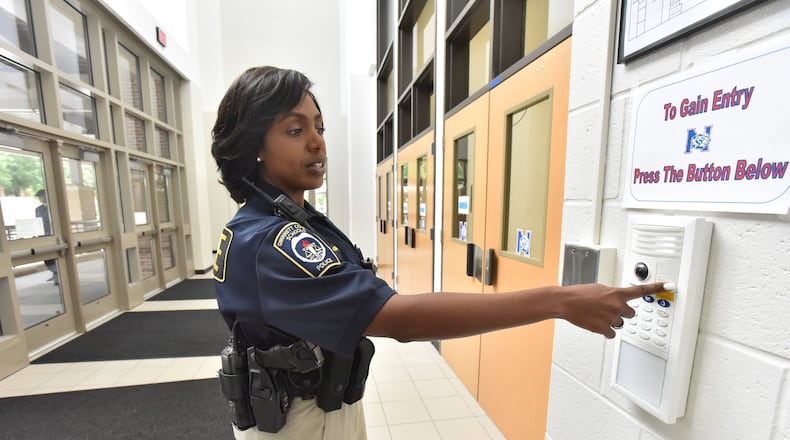With school shootings in America now so common — many groups' tallies say about one a week this year — Georgia legislators are taking a serious look at school safety.
The House and Senate have allocated $16 million and convened committees to address the issue. The end goal is to author legislation that gives school systems safety options, said Sen. John Albers, R-Roswell and Rep. Rick Jasperse, R- Jasper. It may include a budget for recurring funding.
School safety advocates are concerned that $16 million for 180 school districts won’t do much.
The legislators say they don’t want a one-size-fits-all approach, and spreading that sum among so many districts illustrates the difficulty of making real impact on such a broad problem. Big differences in plans for spending the money show that school safety has different emphases in different places. And at least one expert says the most effective safety measures don’t involve the cameras or guns that money can buy.
The state’s formula for allocating the money gives each system a base of $25,000 plus additional money based on enrollment figures. The largest district – Gwinnett County – is on track to receive $1,259,411. The smallest — Taliaferro County — will receive $26,099.
Even Gwinnett’s lion’s share of the school safety grant doesn’t amount to much when you parcel it out. With 184,342 students, that gives the district $6.83 per pupil. Conversely, Taliaferro, which has the equivalent of 164 students, according to the state, gets $159.14 per pupil.
Those figures didn’t surprise Steve Flynt, Gwinnett’s associate superintendent in charge of school improvement and operations. With 10 percent of all public school students in Georgia attending Gwinnett County schools, if the funds would have been equally divided, the district should receive $1.6 million.
“I’m sure it was set up to make sure the smaller districts get enough funding so they can actually do something with it,” said Flynt. “We don’t begrudge Taliaferro their share.”
Taliaferro, about 90 miles east of Atlanta and 50 miles west of Augusta, has about 1,600 residents. Most of whom work outside the county. Superintendent Allen Fort said the biggest school threat is the log trucks rumbling down U.S. 278.
“We’re just about 50 yards from the road,” said Fort, referring to the main building in the school complex. “I’m afraid one day one of those trucks will come crashing through the front door.”
With 175 schoolchildren, Fort is not only the superintendent, but the principal of the high school. The high school, middle school and elementary school are in one complex less than a mile from Interstate 20. The closest commercial building is a Dollar General, referred to as “the mall” which is catty-corner from the school.
When he learned the state had allocated over $26,000 for school safety, Fort had several ideas about what he could spend it on that could be classified as security. They are a far cry from the resources devoted to “security” in, for example, Gwinnett.
First on his list is a better camera for the front entrance. Currently, visitors press a button on a wall to the right of the door. School secretary Louise Paschall, who sits about 20 feet from the door, buzzes them in. She said she recognizes most of the parents and others who regularly come to the school, but being the only one monitoring the security cameras all day, she doesn’t have time to do much screening.
“Ms. Paschall is all we have in terms of security,” said Fort. “This wall of windows isn’t much of a deterrent if someone really wants to get in.”
There have been about three bank robberies in town in the past year, said Fort. With the school being so close to the interstate, he worries that someone fleeing from law enforcement may consider the school a great place to hole up.
“We go on lockdown every time,” he said. “But it won’t take much for someone determined to breach our security system to gain access.”
Intruders with guns were not the predominant concern when the building was built in 2002. The safety concern of that day was getting students out in the event of a fire. Just about every classroom has a door to the outside, and those are mostly glass. Even though every door automatically locks when closed, there’s nothing preventing a teacher from propping a door open to get some fresh air.
With more school districts looking at assigning at least one police officer per school, Fort said he’d use the rest of the state funding for one in Taliaferro. Of course, he’d have to supplement that from his school budget.
However, with facilities smaller than some elementary schools in larger districts, he said he’d have to give the officer more duties than security. “I wouldn’t want him to just sit around all day,” said Fort.
With every student eligible because of low family income for free or reduced-price lunches, he can’t see squandering precious resources on an expenditure that isn’t used daily.
“We’d work out some sort of counseling or mentoring program that would go along with security duties,” he said.
Flynt, in Gwinnett, pointed out that safety isn’t just about locks, cameras and people with guns.
“Last year we had a budget of $7.7 million for safety and security,” he said, adding that besides school police officers, the money went toward maintenance, upgrading facilities, counselors and many other expenses. And many items overlap.
In the 2019 budget, Gwinnett will add 10 more school police officers. With a base salary of $58,911 and benefits costing the district $24,565 per officer, the total compensation averages $83,476 per officer. Adding 10 more will cost Gwinnett more than $800,000, but the system also works closely with the county sheriff's department and police in the local jurisdictions.
“If something happens we may have to work with Homeland Security, GEMA or other similar agencies,” said Flynt. “Communication is important and so is having a plan and practicing that plan.”
He said he welcomes the legislative committee recommendations.
“It can only help in the long run,” he said. “We’re always open to better ways of doing our job.”
But given the increase of school shootings, school safety expert Ken Trump doesn’t believe $16 million is enough.
“Right now there’s enormous pressure on schools and governments to do something — anything,” he said. “The easiest fix is more hardware. So you’ll see a lot of districts buying cameras with no budget for repairing or replacing. Having that security product in place will give a false sense of security.”
Trump, a crisis consultant and president of National School Safety and Security Services, suggests looking for prevention instead of a cure.
“Many security plans lack the people aspect,” he said. “The best security is invisible.”
Making sure all areas of safety and security are addressed is the reason for the safety committees.
The House committee had its first meeting this month in Dawson County. Panel discussions from superintendents and sheriffs culminated with a debate about whether student safety is the primary responsibility of the school system or law enforcement. At the end of the day, Jasperse and many others agreed it’s a joint effort that includes students, parents, businesses and other community stakeholders.
The first meeting of the Senate School Safety Study Committee is set for 9 a. m. June 8 at North Springs High School in Roswell.
Albers said the committee will travel the state and meet with local leaders, school officials, teachers, students, law enforcement and other stakeholders to determine ways each community can keep its schools and children safe. The study committee is responsible for submitting a report of findings and recommendations, including proposed legislation, by Dec. 1.
“We’re not going in with any preconceived notions,” said Albers. “We want to hear from the people. We want to see what’s been done in other places and compile best practices.”
Albers said the diversity of the school districts is certainly a consideration.
“There’s no one size fits all,” he said. “We have very unique school systems in size and area – rural, urban and suburban. We have a moral and legal obligation to make sure each one has a plan that works for it.”
“Cookie-cutter standards could do more harm than good,” he said.
About the Author
Keep Reading
The Latest
Featured



